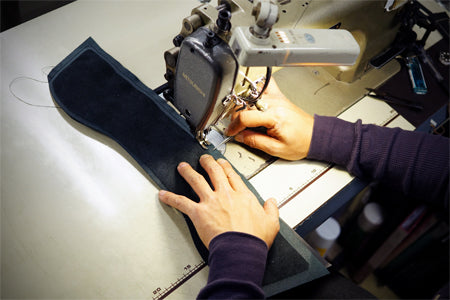
collar and boa
Requests for custom collar boa retrofits are constantly delivered to the factory regardless of the season.
The work consists of two tasks: creating a boa (mouton, coyote, acrylic) that matches the collar of the jacket being brought in, and attaching it (buttoning) around the collar of the jacket.
First, the patterner measures the collar shape of the delivered jacket.

Jacket collars that are subject to collar boa attachment are mostly shirt collars and similar shapes.
So, a little about making the collar...
The collar is usually made up of two parts: the side that is visible on the front (the front collar) and the side that is hidden on the back (the base collar).
These two pieces have different shapes.
The front collar is developed and transformed from the original base collar (the side hidden behind), taking into account the folds when it becomes three-dimensional, the difference in inner and outer diameters, etc., and the degree of transformation is determined by the design and material. For leather jackets, which are often over 1mm thick, relatively large operations are required.
Whenever you sew together two pieces of leather with different shapes, you not only need precise stitching techniques, but you also need to use your hands while imagining the final result.
This is no exception when sewing the base collar and front collar.
At the "turning point" that appears immediately after you start sewing, the stitch is set all at once, about 15 mm during that time.
From there, it's straight for a few centimeters to the tip of the collar, no gaps are required, and it's flat and accurate.
As I approach the first curve, ``neckline'', I slow down, twist the needle movement dial on the sewing machine to change the pitch, and carefully complete the turn.
Pitch back, breathe, start, still part of the neckline, no gap here, progress for a while, and it's almost time.
Pull the base collar from the area where the difference in the inner and outer diameters occurs, and slowly begin to set the front collar, pass the neck point, continue to set it evenly, pass the back center, evenly and evenly...
However, on the pattern paper prepared by the patterner, there are marks indicating stitching in some places, and it is already set up so that if you match the points together, you will get the shape you want. Am I the only one who is suspicious of craftsmen and wonders if the images of themselves and the architect overlap?It seems like the two are always monitoring (confirming) each other somewhere.
Anyway, the collar consists of two pieces.
Since the removable collar boa is attached by covering the collar, a third shape that has been expanded and transformed is required here as well, so the work begins with measuring the collar using a patterner.
Shearling, sheepskin.

It goes without saying that one of the characteristics of shearling, which is a particularly popular material used for collar boas, is its ability to retain heat.
It also has many other attractive features such as good breathability and high water absorption.
Even in seasons when the outside temperature feels warm, the area around the neck that is in direct contact with the shearling boa attached to the collar rarely feels hot or stuffy (depending on the individual), and contrary to its appearance, it is surprisingly comfortable. You can leave it on for a long time.
Deciding when to attach and remove the collar boa is as follows:
``Ah, here we come! The season has arrived when you feel hot around your neck! It's time to take off your boa!''
Rather than internal factors such as
``Does it look really hot? Should I take it off?''
Isn't it influenced by external aspects and public appearance?
To be extreme, shearling is actually a material that is suitable all year round.
Putting aside functionality and trivial poop, the collar has such an impact on a person's impression that it is considered part of the face.
You can wear it whenever you want, and it's also fun to make and replace the collar and boa in different colors.
A boa collar that can be attached or removed depending on your mood is definitely a very convenient item.
By the way, the boa collar of the winter leather jacket that I love has a sewn-in collar that cannot be removed, so when I take the boa off, it means changing clothes. There are good points.
As I mentioned earlier, in the case of a removable boa, the base collar, front collar, and sheepskin are layered on top of that.
Furthermore, since another layer of leather is required to cover the boa over the collar, the volume around the collar increases, resulting in a dignified and masculine impression, but on the other hand, the inner diameter around the neck increases. This means that if your original jacket didn't have enough room around the neck, you may end up feeling a little cramped.
However, what is required from the functional aspect of the collar boa is not only to retain heat around the neck, but also to block the intrusion of outside air, and since a certain degree of airtightness is a welcome effect, changes in the inner diameter are a problem. There is little that happens,
So, what are the advantages of a sewn-in collar boa?
Let's call it the familiarity of a streamlined construction.
However, once you know the convenience of the removable type, the sewn-in type requires a little more preparation, and to put it bluntly, it becomes a situation where you can't afford it, so in the end, both have their advantages and disadvantages.
This is a custom collar and boa retrofit that is constantly delivered regardless of the season.
You can choose from several methods depending on your purpose and preference.
It might be interesting to think about it first.
[Ichijima]


